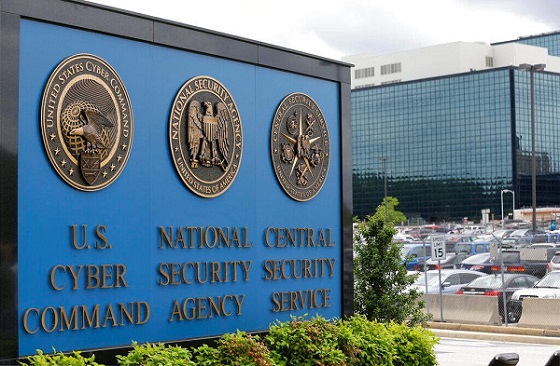Business
The NSA’s Secret Sex Chats

|
|
Intelligence officials maintained a chatroom to discuss polyamory and transgender surgeries, internal documents reveal.
The “intelligence community” is one of the most powerful parts of the American national security apparatus. In theory, it works tirelessly to keep the nation safe. But according to internal documents that we obtained, some intelligence agency employees have another on-the-job priority: sex chats.
We have cultivated sources within the National Security Agency—one current employee and one former employee—who have provided chat logs from the NSA’s Intelink messaging program. According to an NSA press official, “All NSA employees sign agreements stating that publishing non-mission related material on Intelink is a usage violation and will result in disciplinary action.” Nonetheless, these logs, dating back two years, are lurid, featuring wide-ranging discussions of sex, kink, polyamory, and castration.
One popular chat topic was male-to-female transgender surgery, which involves surgically removing the penis and turning it into an artificial vagina. “[M]ine is everything,” said one male who claimed to have had gender reconstruction surgery. “[I]’ve found that i like being penetrated (never liked it before GRS), but all the rest is just as important as well.” Another intelligence official boasted that genital surgery allowed him “to wear leggings or bikinis without having to wear a gaff under it.”
These employees discussed hair removal, estrogen injections, and the experience of sexual pleasure post-castration. “[G]etting my butthole zapped by a laser was . . . shocking,” said one transgender-identifying intel employee who spent thousands on hair removal. “Look, I just enjoy helping other people experience boobs,” said another about estrogen treatments. “[O]ne of the weirdest things that gives me euphoria is when i pee, i don’t have to push anything down to make sure it aims right,” a Defense Intelligence Agency employee added.
These revelations come at a moment of heightened scrutiny for the intelligence community. President Donald Trump, Defense Secretary Pete Hegseth, and Director of National Intelligence Tulsi Gabbard have each made the case that the intelligence agencies have gone “woke,” prioritizing left-wing activism over national security. These chat logs confirm their suspicions and raise fundamental questions about competence and professionalism.
According to our sources, the sex chats were legitimized as part of the NSA’s commitment to “diversity, equity and inclusion.” Activists within the agency used LGBTQ+ “employee resource groups” to turn their kinks and pathologies into official work duties. According to the current NSA employee, these groups “spent all day” recruiting activists and holding meetings with titles such as “Privilege,” “Ally Awareness,” “Pride,” and “Transgender Community Inclusion.” And they did so with the full support of NSA leadership, which declared that DEI was “not only mission critical, but mission imperative.”
In this case, “diversity” was not a byword for racialism, but rather a euphemism for sex talk. Last January, chatroom members discussed their practice of polyamory, or “ethical non-monogamy.” “[A] polycule is a polyamorous group,” one employee explained. “A is my [girlfriend], and B-G are her partners. . . . then B&C are dating but not C&D, nor E, F, or G with any of the others, though there are several MWB (metas-with-benefits) connections.” Another employee claimed to be part of a nine-member “polycule,” adding that “some of our friends are practically poly-mers, with all the connected compounds.”
At other times, the conversations became explicit. The active source at the NSA claimed to have witnessed hundreds of sexually provocative discussions, which, he added, occurred mostly on taxpayer time. The former NSA source who was familiar with the chats recalled being “disgusted” by a particularly shocking thread discussing weekend “gangbangs.”
The NSA sources also raised the question of some staffers’ mental fitness for the job. In one chat, an NSA employee insists on using “it” pronouns in lieu of the human “he” or “she” pronouns. “[I]t/its user here. While I understand we can make some people uncomfortable, keep in mind that the dehumanizing aspect either a) doesn’t apply or b) is a positive effect when we’re requesting it.” A commenter who disagreed was quickly dismissed by employees of the NSA and CIA, who claimed that refusing to use “it/its” pronouns amounted to “erasing” a transgender identity.
“These are folks with top secret clearances believing they are an IT!” said the NSA source.
With the Trump administration taking over, we may see changes. The NSA source said that staffers involved in employee resource groups fear the end of DEI. “[T]here are legal restrictions in place, but this admin has shown they don’t give a f**k about legality,” a staffer in space intelligence remarked about DEI staffers being placed on leave. Others have expressed opposition to Trump’s cabinet nominees.
A conflict is coming. These NSA chat logs suggest the presence of at least hundreds of gender activists within the intelligence services who cannot distinguish between male and female, and who believe that discussing castration, polyamory, and “gangbangs” is an appropriate use of public resources. For psychological and ideological reasons, these kinds of people will not be easily sidelined. The Trump administration should not only dismantle the structure of DEI but also terminate the employees who use it to advance gender activism at the expense of national security.
 |
A guest post by
|
Subscribe to Christopher F. Rufo.
For the full experience, upgrade your subscription.
Business
RFK Jr. says Hep B vaccine is linked to 1,135% higher autism rate

From LifeSiteNews
By Matt Lamb
They got rid of all the older children essentially and just had younger children who were too young to be diagnosed and they stratified that, stratified the data
The Centers for Disease Control and Prevention (CDC) found newborn babies who received the Hepatitis B vaccine had 1,135-percent higher autism rates than those who did not or received it later in life, Robert F. Kennedy Jr. told Tucker Carlson recently. However, the CDC practiced “trickery” in its studies on autism so as not to implicate vaccines, Kennedy said.
RFK Jr., who is the current Secretary of Health and Human Services, said the CDC buried the results by manipulating the data. Kennedy has pledged to find the causes of autism, with a particular focus on the role vaccines may play in the rise in rates in the past decades.
The Hepatitis B shot is required by nearly every state in the U.S. for children to attend school, day care, or both. The CDC recommends the jab for all babies at birth, regardless of whether their mother has Hep B, which is easily diagnosable and commonly spread through sexual activity, piercings, and tattoos.
“They kept the study secret and then they manipulated it through five different iterations to try to bury the link and we know how they did it – they got rid of all the older children essentially and just had younger children who were too young to be diagnosed and they stratified that, stratified the data,” Kennedy told Carlson for an episode of the commentator’s podcast. “And they did a lot of other tricks and all of those studies were the subject of those kind of that kind of trickery.”
But now, Kennedy said, the CDC will be conducting real and honest scientific research that follows the highest standards of evidence.
“We’re going to do real science,” Kennedy said. “We’re going to make the databases public for the first time.”
He said the CDC will be compiling records from variety of sources to allow researchers to do better studies on vaccines.
“We’re going to make this data available for independent scientists so everybody can look at it,” the HHS secretary said.
— Matt Lamb (@MattLamb22) July 1, 2025
Health and Human Services also said it has put out grant requests for scientists who want to study the issue further.
Kennedy reiterated that by September there will be some initial insights and further information will come within the next six months.
Carlson asked if the answers would “differ from status quo kind of thinking.”
“I think they will,” Kennedy said. He continued on to say that people “need to stop trusting the experts.”
“We were told at the beginning of COVID ‘don’t look at any data yourself, don’t do any investigation yourself, just trust the experts,”‘ he said.
In a democracy, Kennedy said, we have the “obligation” to “do our own research.”
“That’s the way it should be done,” Kennedy said.
He also reiterated that HHS will return to “gold standard science” and publish the results so everyone can review them.
Business
Elon Musk slams Trump’s ‘Big Beautiful Bill,’ calls for new political party

From LifeSiteNews
By Robert Jones
The Tesla CEO warned that Trump’s $5 trillion plan erases DOGE’s cost-cutting gains, while threatening to unseat lawmakers who vote for it.
Elon Musk has reignited his feud with President Donald Trump by denouncing his “Big Beautiful Bill” in a string of social media posts, warning that it would add $5 trillion to the national debt.
“I’m sorry, but I just can’t stand it anymore. This massive, outrageous, pork-filled Congressional spending bill is a disgusting abomination. Shame on those who voted for it: you know you did wrong. You know it,” Musk exclaimed in an X post last month.
I’m sorry, but I just can’t stand it anymore.
This massive, outrageous, pork-filled Congressional spending bill is a disgusting abomination.
Shame on those who voted for it: you know you did wrong. You know it.
— Elon Musk (@elonmusk) June 3, 2025
Musk renewed his criticism Monday after weeks of public silence, shaming lawmakers who support it while vowing to unseat Republicans who vote for it.
“They’ll lose their primary next year if it is the last thing I do on this Earth,” he posted on X, while adding that they “should hang their heads in shame.”
Every member of Congress who campaigned on reducing government spending and then immediately voted for the biggest debt increase in history should hang their head in shame!
And they will lose their primary next year if it is the last thing I do on this Earth.
— Elon Musk (@elonmusk) June 30, 2025
The Tesla and SpaceX CEO also threatened to publish images branding those lawmakers as “liars.”
Trump responded on Truth Social by accusing Musk of hypocrisy. “He may get more subsidy than any human being in history,” the president wrote. “Without subsidies, Elon would probably have to close up shop and head back home to South Africa… BIG MONEY TO BE SAVED!!!”
( @realDonaldTrump – Truth Social Post )
( Donald J. Trump – Jul 01, 2025, 12:44 AM ET )Elon Musk knew, long before he so strongly Endorsed me for President, that I was strongly against the EV Mandate. It is ridiculous, and was always a major part of my campaign. Electric cars… pic.twitter.com/VPadoTBoEt
— Donald J. Trump 🇺🇸 TRUTH POSTS (@TruthTrumpPosts) July 1, 2025
Musk responded by saying that even subsidies to his own companies should be cut.
Before and after the 2024 presidential election, Musk spoke out about government subsidies, including ones for electric vehicles, stating that Tesla would benefit if they were eliminated.
This latest exchange marks a new escalation in the long-running and often unpredictable relationship between the two figures. Musk contributed more than $250 million to Trump’s reelection campaign and was later appointed to lead the Department of Government Efficiency (DOGE), which oversaw the termination of more than 120,000 federal employees.
Musk has argued that Trump’s new bill wipes out DOGE’s savings and reveals a deeper structural problem. “We live in a one-party country – the PORKY PIG PARTY!!” he wrote, arguing that the legislation should be knows as the “DEBT SLAVERY bill” before calling for a new political party “that actually cares about the people.”
It is obvious with the insane spending of this bill, which increases the debt ceiling by a record FIVE TRILLION DOLLARS that we live in a one-party country – the PORKY PIG PARTY!!
Time for a new political party that actually cares about the people.
— Elon Musk (@elonmusk) June 30, 2025
In June, Musk deleted several inflammatory posts about the president, including one claiming that Trump was implicated in the Jeffrey Epstein files. He later acknowledged some of his comments “went too far.” Trump, in response, said the apology was “very nice.”
With the bill still under Senate review, the dispute underscores growing pressure on Trump from fiscal hardliners and tech-aligned conservatives – some of whom helped deliver his return to power. Cracks in the coalition may spell longer term problems for the Make America Great Again movement.
-

 Business17 hours ago
Business17 hours agoRFK Jr. says Hep B vaccine is linked to 1,135% higher autism rate
-

 Alberta2 days ago
Alberta2 days agoAlberta Independence Seekers Take First Step: Citizen Initiative Application Approved, Notice of Initiative Petition Issued
-

 Crime1 day ago
Crime1 day agoNational Health Care Fraud Takedown Results in 324 Defendants Charged in Connection with Over $14.6 Billion in Alleged Fraud
-

 Crime2 days ago
Crime2 days agoSuspected ambush leaves two firefighters dead in Idaho
-

 Alberta2 days ago
Alberta2 days agoWhy the West’s separatists could be just as big a threat as Quebec’s
-

 Business2 days ago
Business2 days agoCanada Caves: Carney ditches digital services tax after criticism from Trump
-

 Health1 day ago
Health1 day agoRFK Jr. Unloads Disturbing Vaccine Secrets on Tucker—And Surprises Everyone on Trump
-

 Censorship Industrial Complex17 hours ago
Censorship Industrial Complex17 hours agoGlobal media alliance colluded with foreign nations to crush free speech in America: House report



